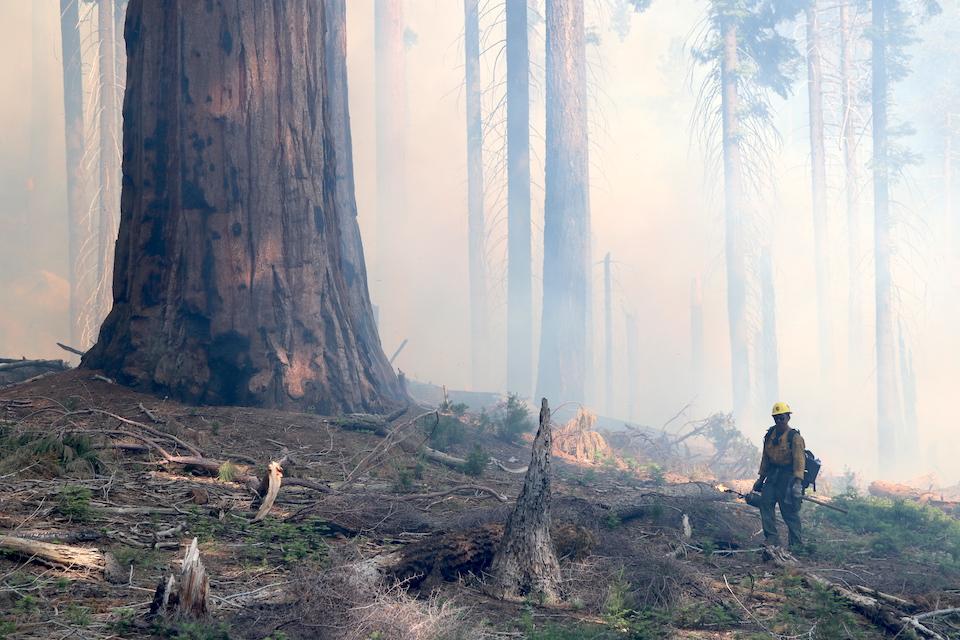
Fire managers at Sequoia and Kings Canyon National Parks successfully ignited 245 acres on the Sherman Prescribed Burn in July 2019/NPS
As concerns continue to mount over the wildfires burning across Australia, the National Park Service is pointing to the steps it took during Fiscal Year 2019 to reduce wildfire risks in the National Park System and surrounding communities.
Park Service Deputy Director David Vela said the other day that the agency treated 230,308 acres of public land during the fiscal year.
Prescribed fire was used to treat nearly 207,000 acres, and an additional 24,000 acres were treated by mechanical (vegetation removal) and other methods. A robust vegetation management program improves the resiliency of landscapes to wildfires and preserves public lands for a variety of uses and enjoyment by the public, according to the Park Service.
“The accomplishments of our fire and aviation programs are vital to meeting our mission as well as the (Interior) Secretary’s priorities,” said Vela. “We are proud of the dedication and hard work completed over the past year by the men and women of the aviation, structural and wildland fire programs.”
In FY 2019, the bureau reached a milestone with more than 90 percent of the 31,339 structures listed in the NPS Wildland Fire Geodatabase now surveyed for threats from wildland fire. Also in 2019, the areas adjacent to more than 6,000 structures were treated and the potential of risk from wildfire was reduced.
Research in wildland fire to better inform and fuels management is another high priority for the NPS. In 2019, the following five research projects were funded totaling $157,000:
-
Whiskeytown National Recreation Area, California: Effectiveness of Fuel treatments on Wildfire in a Chaparral Community
-
Valles Caldera National Preserve, New Mexico: Identifying Activity Periods of an Endangered Salamander to Facilitate Fuels Treatments
-
Great Smoky Mountains National Park, Tennessee/North Carolina: Changes in Woody Fuel Loading and Ericaceous Shrub Cover from 2003 to 2019 in Great Smoky Mountains NP
-
Yukon-Charley Rivers National Preserve, Alaska: Fire and Ice – integrated fire research to inform managers on the short and long term impacts of fire and climate on ice-rich permafrost soils, water resources, vegetation and wildlife habitat
-
Yellowstone, Grand Teton, Glacier national parks, Wyoming and Montana: Drivers of Early Postfire Tree Regeneration and Indicators of Forest Resilience in National Parks of the Northern Rocky Mountains
Within the NPS Structural Fire Program, NPS revised and updated all structural fire classes and added a hazardous materials class; this provides bureau structural firefighters with all the multi-faceted training needed for certification. More than 150 NPS employees were trained in structural firefighting, including 41 new firefighters, 26 new driver operators and 92 at firefighter refresher classes. In addition, 34 new park structural fire coordinators were trained during 2019. The program has also developed cancer awareness and prevention procedures and a grant to support structural firefighter gear cleaning for cancer prevention in parks.
Aviation continues to be an important multidisciplinary program for the NPS. In 2019, aviation resources supported wildland fire, search and rescue, law enforcement, and natural resources studies, surveys, and research missions. Approximately 11,000 hours of flight time, from 7,400 flights were conducted in 2019.
In addition to treatment projects conducted domestically, the DOI and U.S. Forest Service continue to support ongoing efforts to combat the wildfires in Australia. At the request of the Australian Fire and Emergency Service Authorities Council, DOI and the USFS have deployed 150 firefighters thus far, including 10 from the NPS.
“The loss of life, property and environment are devastating in Australia,” said Interior Secretary David Bernhardt. “The United States stands with our partners, and we will continue to support Australia in sending our world class personnel to contain these blazes and help protect Australian communities and wildlife.”

 Support Essential Coverage of Essential Places
Support Essential Coverage of Essential Places






